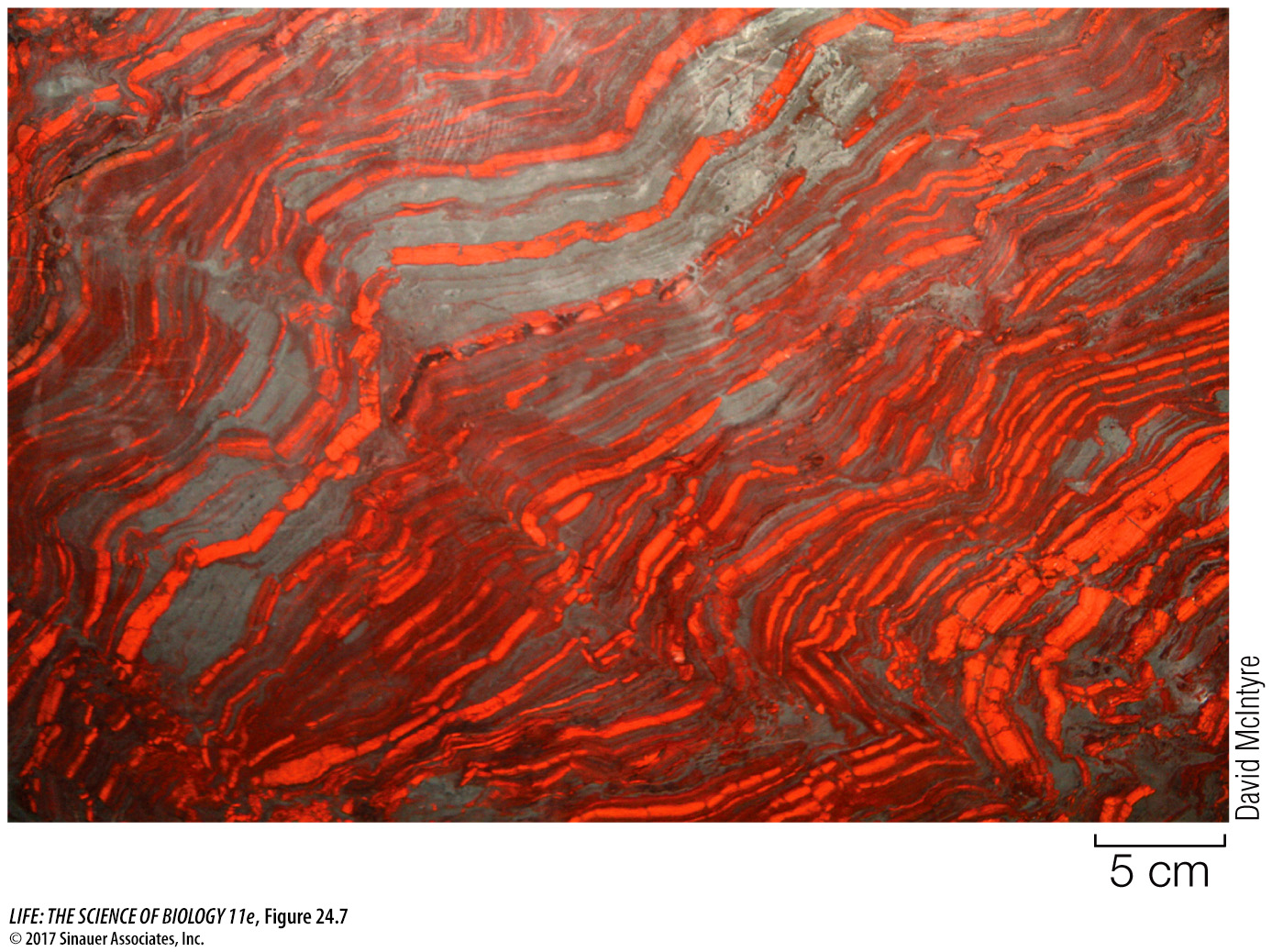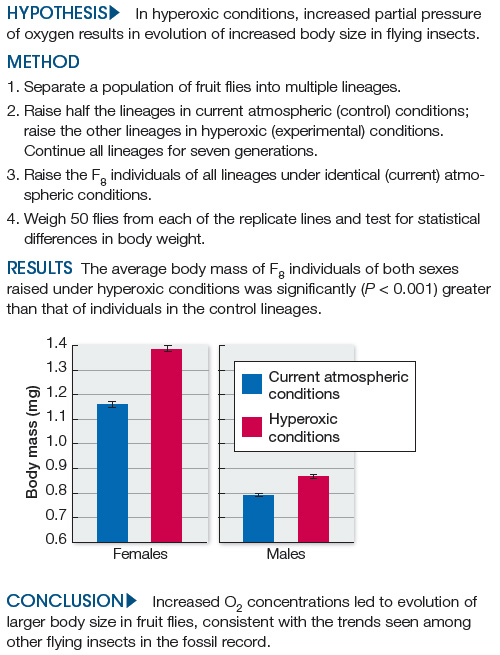Oxygen concentrations in Earth’s atmosphere have changed over time
As the continents have moved over Earth’s surface, the world has experienced other physical changes, including large increases and decreases in atmospheric oxygen concentrations. The atmosphere of early Earth probably contained little or no free oxygen gas (O2). The increase in atmospheric O2 came in two big steps more than a billion years apart.
The first step occurred at least 2.4 billion years ago (bya), when certain bacteria evolved the ability to use water as the source of hydrogen ions for photosynthesis. By chemically splitting H2O, these bacteria generated O2 as a waste product. They also made electrons available for reducing CO2 to form the carbohydrate end-

The second step occurred about a billion years later, when some of these photosynthetic bacteria became symbiotic within eukaryote cells, leading to the evolution of chloroplasts in photosynthetic plants and other eukaryotes. This change resulted in continued accumulation of O2 in Earth’s atmosphere (Figure 24.8).

Q: Why did oxygen levels decrease at the end of the Permian?
Ash and gases produced by massive volcanic eruptions near the end of the Permian blocked sunlight and resulted in rapid cooling of Earth. There was massive die-
One group of O2-generating bacteria, the cyanobacteria, were a major component of complex communities that formed rocklike structures called stromatolites, which are abundantly preserved in the fossil record. To this day, stromatolites are still formed in a few very salty places (Figure 24.9). Cyanobacteria liberated enough O2 to open the way for the evolution of oxidation reactions as the energy source for the synthesis of ATP.

Thus the evolution of life irrevocably changed the physical nature of Earth. Those physical changes, in turn, influenced the evolution of life. When it first appeared in the atmosphere, O2 was toxic to most of the anaerobic prokaryotes that inhabited Earth at the time. Over millennia, however, prokaryotes that evolved the ability to tolerate and use O2 not only survived but gained the advantage. Aerobic metabolism proceeds more rapidly, and harvests energy more efficiently, than anaerobic metabolism. Organisms with aerobic metabolism replaced anaerobes in most highly oxygenated environments.
An atmosphere rich in O2 also made possible larger and more complex organisms. Small single-
Probably because it took many millions of years for Earth to develop an oxygenated atmosphere, only single-
Oxygen concentrations increased again during the Carboniferous and Permian periods because of the evolution of large vascular plants. These plants lived in the expansive lowland swamps that existed at the time (see Table 24.1). Massive amounts of organic material were buried in these swamps as the plants died, leading to the formation of Earth’s vast coal deposits. Because the buried organic material was not subject to oxidation as it decomposed, and because the living plants were producing large quantities of O2, atmospheric O2 increased to concentrations that have not been reached again in Earth’s history (see Figure 24.8). As mentioned at the opening of this chapter, these high concentrations of atmospheric O2 allowed the evolution of giant flying insects and large amphibians that could not survive in today’s atmosphere.
The drying of the lowland swamps at the end of the Permian reduced burial of organic matter as well as the production of O2, so atmospheric O2 concentrations dropped rapidly. Over the past 200 million years, with the diversification of flowering plants, O2 concentrations have again increased, but not to the levels that characterized the Carboniferous and Permian periods.
Biologists have conducted experiments revealing the changing selection pressures that can accompany changes in atmospheric O2 concentrations. When fruit flies (Drosophila) are raised in hyperoxic conditions (i.e., with artificially increased atmospheric concentrations of O2), they evolve larger body sizes in just a few generations (Investigating Life: The Relationship between Atmospheric Oxygen Concentration and Body Size in Insects). The present atmospheric O2 concentrations appear to constrain body size in these flying insects, whereas increases in O2 appear to relax those constraints. This experiment demonstrates that the *stabilizing selection on body size at current O2 concentrations can quickly switch to directional selection for a change in body size in response to a change in O2 concentrations.
*connect the concepts Stabilizing selection resists change from a current state, whereas directional selection results in change away from the current state (see Key Concept 20.4).
investigating life
The Relationship between Atmospheric Oxygen Concentration and Body Size in Insects
experiment
Original Paper: Klok, C. J., A. J. Hubb and J. F. Harrison. 2009. Single and multigenerational responses of body mass to atmospheric oxygen concentration in Drosophila melanogaster: Evidence for roles of plasticity and evolution. Journal of Evolutionary Biology 22: 2496–
C. Jaco Klok and his colleagues asked whether insects raised in hyperoxic conditions (i.e., in an atmosphere having a higher partial pressure of oxygen than is normal today) would evolve to be larger than their counterparts raised under today’s atmospheric conditions. They raised strains of fruit flies (Drosophila melanogaster) under both conditions to test the effects of increased O2 concentrations on the evolution of body size.

work with the data
Original Papers: Harrison, J. F. and G. G. Haddad. 2011. Effects of oxygen on growth and size: Synthesis of molecular, organismal and evolutionary studies with Drosophila melanogaster. Annual Review of Physiology 73: 13.1–
Harrison, J. F., A. Kaiser and J. M. VandenBrooks. 2010. Atmospheric oxygen level and the evolution of insect body size. Proceedings of the Royal Society of London B 277: 1937–
The data in the bar graphs show that the body mass of individuals in the experimental populations of Drosophila increased, on average, about 2 percent per generation under hyperoxic conditions (although the rate of increase was not constant over the experiment). Here you will extrapolate from Harrison et al.’s study to determine whether the observed rate of increase in body mass per generation that these researchers observed in Drosophila is sufficient to account for the giant dragonflies of the Permian period.
QUESTIONS
1.
Suppose that the average rate of increase in dragonfly size during the Permian was much slower than the rate observed in the experiment. For this exercise, assume that the actual rate of increase for dragonflies was just 0.01 percent per generation, rather than the 2 percent observed over a few generations for Drosophila. Also assume that dragonflies complete only 1 generation per year (as opposed to 40 or more generations for Drosophila). Starting with an average body mass of 1 gram, calculate the projected increase in dragonfly body mass over 50,000 years. This calculation is similar to computing compound interest for a savings account. Use the formula W = S(1 + R)N where W = the final mass, S = the starting mass, R = the rate of increase per generation (0.0001 in this case), and N = the number of generations.
Since W = S(1 + R)N, then W = (1 g)(1.0001)50,000 = 148.38 grams.
2.
What percent of the Permian period does 50,000 years represent? Use Table 24.1 for your calculation.
The Permian lasted 48 million years (299 mya to 251.0 mya); therefore 50,000 years represents about one-
3.
Given your calculations, do you think that increased O2 concentrations during the Permian were sufficient to account for the evolution of giant dragonflies? Why or why not?
Given that even a very modest increase in body size of 0.01 percent per generation is enough to result in an increase in body mass from 1 gram to more than 148 grams in just 50,000 years; that 50,000 years represents only about one-
A similar work with the data exercise may be assigned in LaunchPad.